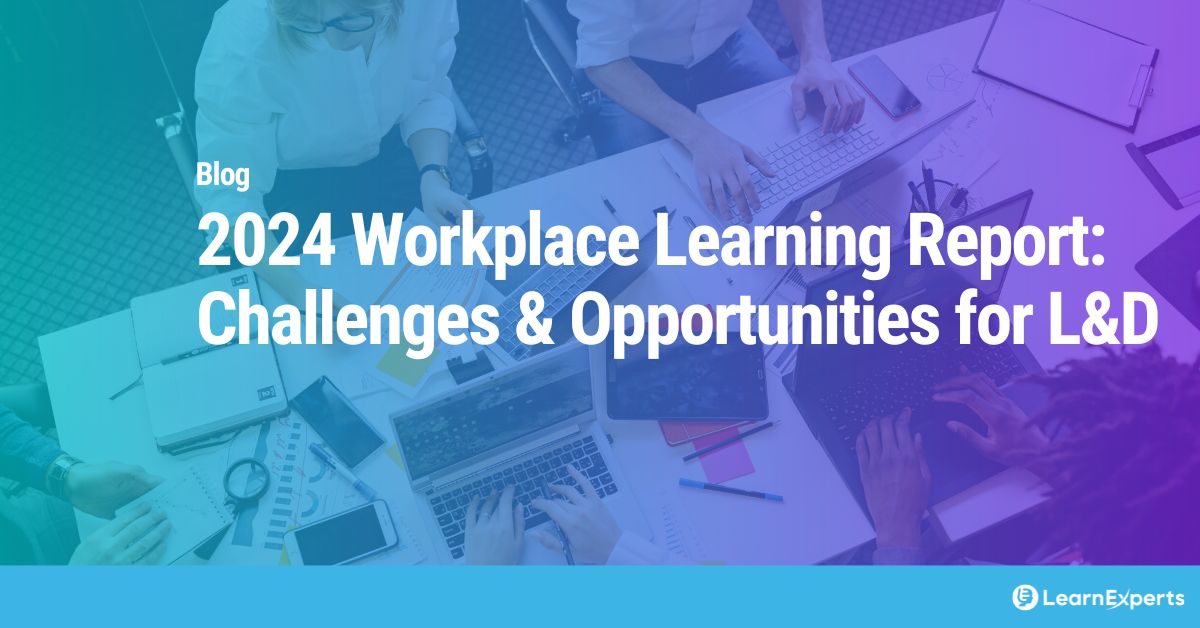AI was the central theme in this year’s LinkedIn Workplace Learning Report, and according to the influential annual report, L&D (learning and development) departments can deliver greater business innovation and critical skills with the help of this technology.
The LinkedIn report found that 4 in 5 people want to learn more about how to use AI in their profession. Interestingly, AI was also on the mind of the over 1,000 HR/L&D professionals who responded to the 2024 HR/L&D Trends Survey by Blanchard. According to that report,
- 27% said AI will impact their HR/L&D work to a large/very large extent in 2024
- 30% said they were using AI as a learning tool now
- 91% of current users plan to expand the use of AI in 2024
- 46% of those not using AI said they plan to start using it as a learning tool in 2024.
HR respondents are most interested in using AI to assist in career development by analyzing an employee’s skills, offering suggestions on which skills should be addressed, and analyzing employee data and provide insights to managers on employee performance.
L&D leaders are interested in using AI to evaluate learner needs, suggest content, create educational content, and offer chatbots to provide real-time feedback and guidance.
In this blog, we look at the future of learning and development, including…
Workplace Learning Report: Top L&D priorities
The 1,636 L&D and HR professionals with L&D responsibilities who took part in the LinkedIn survey stated that the five focus areas of L&D for 2024 were:
- Aligning learning programs to business goals
- Upskilling employees
- Creating a culture of learning
- Helping employees develop their careers (up from number 9 in 2023)
- Improving employee retention
For organizations looking to align learning with business goals and help employees develop their careers, internal mobility is an effective solution. According to the LinkedIn Workplace Learning Report, 87% of L&D pros say they can show business value by helping employees gain skills to move into different internal roles.
And companies are responding by maintaining and growing L&D budgets. According to the LinkedIn Executive Confidence Index, in the next six months, nine out of ten global executives plan to increase or maintain their investment in L&D, including upskilling and reskilling.
Companies can’t go wrong when they invest in building a learning culture. Those with strong learning cultures see higher retention rates, more internal mobility, and a healthier management pipeline than those with smaller commitment levels. Compared to the baseline learning culture, companies with a strong learning culture enjoyed 57% higher retention, 23% higher internal mobility, and 7% higher promotions to management.
The Workplace Learning Report also found that 7 in 10 say learning improves their sense of connection to their organization, while 8 in 10 say learning adds purpose to their work. These findings help ensure that employees remain at organizations.
Learning and development challenges
Challenges are abound but here are the challenges that were identified by a few industry reports. According to Blanchard’s 2024 HR/L&D Trends Survey, five things that are keeping HR and L&D professionals up at night are:
- Attracting and retaining the right talent with the necessary skills and experience
- Aligning talent development with business objectives
- Increasing individual capabilities to keep pace with the rapid rate of change.
- Budget and resource constraints
- Creating a positive employee experience and maintaining high levels of engagement.
Gartner’s Leadership Vision for Learning and Development Leaders in 2024 had a slightly different perspective, but look carefully, and you will see some common themes:
- “Unsettled” employee-employer relationship – Remote work, productivity expectations, and the push for organizational transformation are straining relationships between management and employees.
- Persistent skills shortages – 83% of HR leaders say they struggle to find enough talent with the necessary skills, and another 57% said skill shortages undermine their ability to sustain corporate performance.
- Transformative technology innovations – employees expect to use AI, and leaders expect AI implementations, but only 22% of HR leaders are highly engaged in GenAI discussions. Leaders should not take the impact of AI lightly. A recent IBM report surveyed 300 C-suite executives across 22 industries, and they estimate that 40% of their workforce will need to reskill in the next three years due to AI and automation.
- Pressure for operational efficiency—HR is pressured to justify its investments, and workforce productivity is a dominant success measure.
Recommendations for L&D leaders
The Linked Workplace Learning Report had the following recommendations for L&D leaders:
- Lean into analytics to align learning programs to business strategies
- Avoid vanity metrics such as employee satisfaction and training delivered and opt for metrics like employee performance, productivity and retention, as well as business impacts (sales closed, customer satisfaction scores) and new skills learnt.
- Focus on developing human skills like interpersonal, presentation, problem-solving and people management skills.
- Embrace microlearning to build engaging, personalized, and flexible learning to help people solve specific problems. According to the report, 47% of L&D teams plan to implement microlearning in 2024.
Here are six recommendations from Gartner’s Leadership Vision for Learning and Development Leaders in 2024 on where L&D leaders should focus their efforts:
- Review leadership competencies and expectations within your organization.
- Prioritize and implement updates to development programs for managers and rising and established leaders.
- Review your learning strategy and prioritize learning needs that deliver skills aligned to critical, strategic objectives.
- Partner with stakeholders like managers, employees and leaders to build support for learning.
- Link learning opportunities to overall career growth.
- Identify partners in and outside the organization to build learning opportunities.
TalentLMS and Vyond found that 80% of employees surveyed think personalized learning will be important in 2024. They also found that employees are highly motivated to explore AI, and the technology will be critical for unlocking new opportunities, measuring and bridging skill gaps, and driving innovation. They had the following recommendations for employers:
- Fast-track the development of new skills
- Fire up internal mobility to address skill gaps
- Embed learning into the workflow
- Shift from a content-centric to a learner-centric approach
- Empower learners with data
- Craft captivating learning experiences
- Develop a learning culture as learning takes a village
Finally, here are learning and development trends for 2024 from Robin Hoyle, Head of Learning Innovation at Huthwaite International.
- Apply GenAI to internal data for a competitive advantage
- Measure impact for a greater focus on L&D
- Invest in high-quality human-to-human communication to adapt as AI evolves
How LEAi helps L&D teams
Designed by experienced learning experts, LEAi can efficiently address many of the challenges faced by L&D teams. LEAi is our GenAI tool that allows businesses to use their internal data to build training content optimized for learning.
The content created by LEAi is also designed to allow our users to develop once and then use that learning content in various ways like instructor-led training, eLearning, knowledge base articles, virtual class content, presentations, webinars, videos and more. Here is how LEAi addresses some of the learning and development challenges:
Challenge: Lack of time
Solution with LEAi: Since LEAi uses existing content within an organization and creates the training content for you, it reduces the time it takes to develop training content. In fact, according to our calculations, it takes over 58 hours to create 1 hour of training content using traditional processes on average. With LEAi, it only takes about 17 hours, translating to a 67% reduction in the time needed to develop training content.
Challenge: Low knowledge retention
Solution with LEAi: The content created by LEAi is designed to follow our training framework of “Tell me. Show me. Let me try. Test me.” where you instruct the learner on the concepts, demonstrate the ideas, let them try on their own by allowing them to do the practical application, and then perform a knowledge check to see if they have understood the concepts. This aids in both learner engagement and knowledge retention.
Challenge: Finding the right content
Solution with LEAi: With LEAi, finding the right content is so much less of an issue. Simply upload various documents from your subject-matter experts, and LEAi does the work to create the training content. The content used to develop training can be documents, presentations, webpages, wikis, and community content.
Challenge: Updating the content
Solution with LEAi: LEAi has a course updater feature that intelligently updates changes to all your courses in seconds so that you can eliminate the mundane task of updating individual courses.
LEAi can address many more challenges faced by L&D creators in 2024, including reducing the time to roll out new courses and keeping courses updated so they can keep employees interested and engaged. Let us give you a demo and show you how we can help you meet your objectives.




